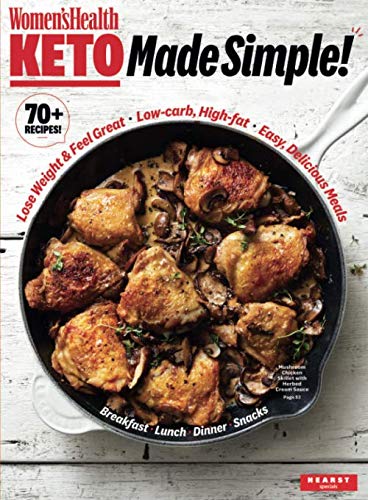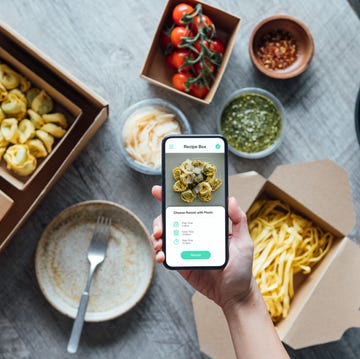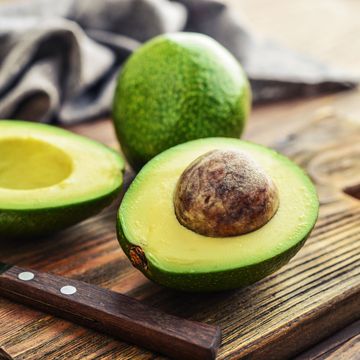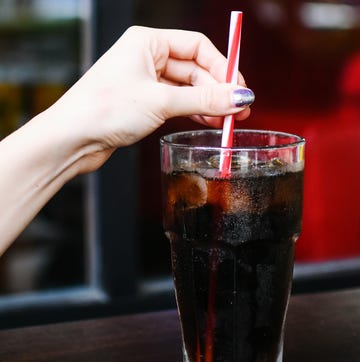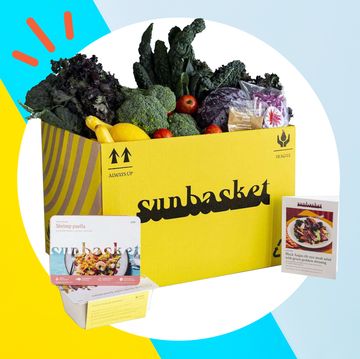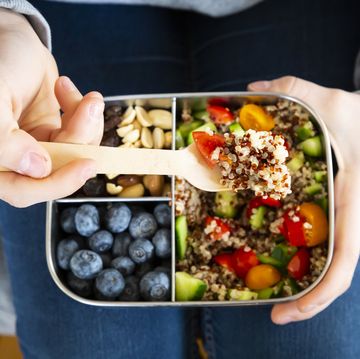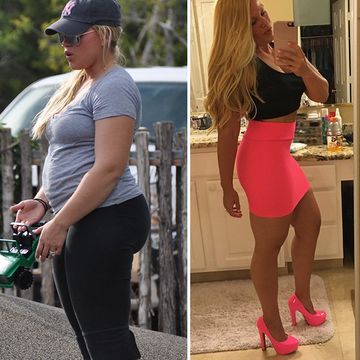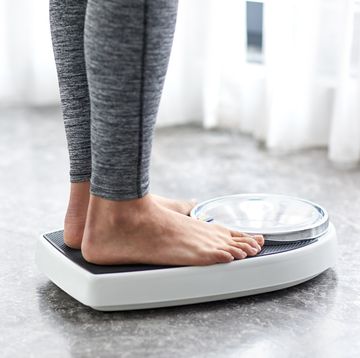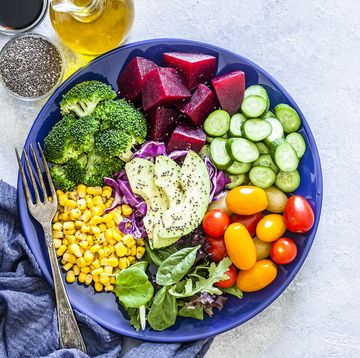It's no secret that the keto diet is pretty strict. The high-fat, low-carb diet requires that you pay close attention to what you eat. But before you mourn the fact that you won't be able to eat your carb-heavy faves anymore (although you will be missed, french fries and baked goods from the coffee shop), know that the keto food list is packed with a ton of delicious items. So, rest assured, you won't feel completely deprived.
Preparation is key—it's important to know what will work (and what won't) before you hit the grocery store and load up your cart. For starters, you’ll definitely want to opt for good-for-you sources of unsaturated fat and protein—like fish and avocado, instead, says Lyssie Lakatos, RDN, of the Nutrition Twins. “Since this diet is primarily coming from fat, choosing healthy sources of fat is important,” she says.
So, healthy fat and protein are good; but what about everything else? To help, a few dietitians weighed in on what they'd put on their keto diet grocery shopping list—so all you really have to do is save it and go to the store. And this list has everything from fruit to veggies to nut mils and CHEESE. Yes, we said cheese. Keep reading to find out what you should skip at the grocery store, and what you should be stocking up on.
Meet the experts: Lyssie Lakatos, RDN, has over 15 years of experience in counseling clients in nutrition. She and her twin sister, Tammy Lakatos Shames, were voted among the Top 20 Nutrition Experts to Follow on Twitter by the Huffington Post.
Marisa Moore, RDN, is a food and nutrition expert who has been working with clients on weight and disease management for over 10 years. She also collaborates with the food and restaurant industry to develop and promote healthy recipes, food products and campaigns.
First of all, what are the basic rules of the keto diet and how do you get started?
While everyone's body and needs are slightly different, the traditional keto diet typically follows this formula:
- 60 to 75 percent of your calories come from fat
- 15 to 30 percent of your calories come from protein
- 5 to 10 percent of your calories come from carbs
That usually means eating no more than 50 grams of carbs a day (some strict keto dieters even opt for just 20 grams a day), though there are some more flexible versions of the keto diet. After about two to seven days of following the keto diet, you go into ketosis, or the state your body enters when it doesn't have enough carbs for your cells to use for energy. That's when you start making ketones, or organic compounds that your bod then uses in place of those missing carbs. At this point, your body also starts burning fat for more energy, leading to weight loss.
If you're not sure what to eat to get started on the keto diet, you can find plenty of yummy recipes for breakfast, lunch, and dinner here. Once you get familiar with eating low-carb, you'll be able to whip up your own meals that fit into the keto diet (and the grocery list above will help with that).
So, what items should I take off my grocery list?
There are a few aisles you can skip (the cookie aisle is probably one of them, sorry) if you're committing to keto. Here are the non-keto-friendly items you will no longer need to stock your fridge and pantry with.
- Pasta and other grains. When you're cutting carbs on keto, pasta, rice, and noodles have to be the first to go (unfortunately). Your local grocery store might have a special health foods section where you can find low-carb or gluten-free pastas and noodles, though.
- Starchy veggies. Potatoes are off limits, and so are other starchy, high-carb vegetables like carrots, believe it or not. Colorful, leafy greens are going to be key staples to add to your basket or cart. Specifically, these starchy veggies you should nix include:
- Corn (1 cup): 123.3 g total carbs, 111.2 g net carbs
- Green peas (1 cup): 21 g total carbs, 12.5 g net carbs
- Beets (0.5 cup): 13 g total carbs, 9.1 g net carbs
- Sweet potatoes (1 medium sweet potato): 23.6 g total carbs, 19.8 g net carbs
- Butternut squash (0.5 cup): 12.6 g total carbs, 8.7 g net carbs
- High-sugar fruits. While fruit is something that is usually recommended for a healthy, balanced diet, the keto diet restricts some fruit, says Marisa Moore, MBA, RDN, LD. Some fruits, like apples, bananas, and pears, are higher in carbs, which break down into sugars, so they're not typically part of a keto eating plan.
- Apple (Red Delicious, 1 cup): 15.3 g total carbs, 12.8 g net carbs
- Banana (1 medium banana): 27 g total carbs, 23.9 g net carbs
- Pear (1 small pear) : 22.9 g total carbs, 18.3 g net carbs
- Grapes (Red seedless grapes, 100g): 15.7 g total carbs, 15 g net carbs
- Cherries (1 cup): 24.7 g total carbs, 18.2 g net carbs
- Legumes. If you eat vegan or vegetarian, certain legumes, like beans, lentils, and chickpeas, might be a regular part of your diet for extra protein. On keto, though, they're too high in carbs and too low in fat to be compliant.
- Black beans (1 cup): 40.8 g total carbs, 25.8 g net carbs
- Red beans (1 cup): 46 g total carbs, 35 g net carbs
- Great Northern beans (1 cup): 34 g total carbs, 22 g net carbs
- Lentils (1 cup): 38 g total carbs, 32 g net carbs
- Chickpeas (1 cup): 44 g total carbs, 32 g net carbs
- Sugary foods. You're going to want to bypass any aisle that includes candy, doughnuts, snack cakes, and cookies, as the sugars in any processed sweets should be avoided on the keto diet.
Your keto-friendly grocery list
Okay, now that we've gotten the bad news out of the way, here are all the yummy items you can stock up on when you're following a keto diet. There's plenty to be excited about!
Low-carb Veggies
Not all vegetables are created equal for keto followers. High-carb veggies are a no-go. Instead, opt for low-carb options like cauliflower, broccoli, spinach, bell pepper, celery, cucumber, eggplant, and asparagus, says Pegah Jalali, RD, a nutritionist with Middleberg Nutrition.
Here's a peek at the carbs.
- Cauliflower (1 cup): 5.3 g total carbs, 3.1 g net carbs
- Cucumber (1 cup): 3.8 g total carbs, 2.5 g net carbs
- Spinach (1 cup): 1.1 g total carbs, 0.4 g net carbs
- Bell pepper (1 cup): 9 g total carbs, 5.7 g net carbs
- Celery (1 cup): 3 g total carbs, 0.9 g net carbs
Frozen veggies are cool too. Sydney Greene, RD, also of Middleberg Nutrition, recommends frozen cauliflower in particular. “It’s very low carb yet high in fiber and vitamin C. Use cauliflower in place of bananas for a creamy smoothie without the extra carbohydrates,” she says.
Avocados
Tammy Lakatos Shames, RDN, of Nutrition Twins, describes avocados as one of the very best keto foods, jam-packed with both nutrients and healthy fats. Jalali likes to have them with some hemp or flax seeds sprinkled on top and some parmesan cheese.
Berries
Raspberries are a perfect sweet treat for people on the keto diet since they're the fruit with the fewest carbs, says Jalali—though blueberries and blackberries are great too. Blackberries and raspberries specifically are a solid option because they contain eight grams of fiber per cup too, Moore adds.
- Blackberries (1 cup): 13.8 g total carbs, 6.1 g net carbs,
- Blueberries (1 cup): 21 g total carbs, 17.5 g net carbs
- Raspberries (1 cup): 4.7 g total carbs, 6.6 g net carbs
- Strawberries (1 cup): 11.1 g total carbs, 7.9 g net carbs
- Goji berries (1 cup): 3.5 g total carbs, 3.5 g net carbs
Salad Greens
Pre-washed greens, like spinach, kale, and arugula, are a huge time-saver. “Having greens on hand makes it super easy to throw together a quick salad or add some quick nutrients—folate, vitamin C, fiber, magnesium—to your proteins,” says Greene.
For a quick, keto-friendly breakfast, Greene suggests scrambling two whole eggs and a handful of spinach to get a good serving of healthy fat, protein, and fiber.
Grass-fed Beef and Organic Chicken
Keep grass-fed beef and lamb, along with organic chicken, on hand, says Jalali. “Our clients particularly love Applegate’s Great Organic Uncured Beef Hot Dog,” says Shames—they’re non-GMO and made with grass-fed beef, sans nitrates and preservatives.
Bone Broth
Another option? Sip your meat-based protein. Greene loves Bonafide Provisions Bone Broth, which uses bones from grass-fed cows. “The amino acids found in the broth support a healthy gut,” says Greene.
Tuna, Salmon, or Sardines (Fresh or Canned)
If you opt for fresh fish, grill, bake, or pan-fry it in a healthy oil (olive or avocado) and serve with a low-carb veggie like broccoli or cauliflower rice.
If you choose canned, mix it with mayo and serve over greens, suggests Jalali. For a simple keto lunch, Greene suggests combining a can of tuna with half an avocado in a collard green wrap.
Cheese
Go for grass-fed, organic, and full-fat options in the dairy aisle, recommends Jalali. For cheese, one easy-to-find option—readily available at groceries and convenience stores alike—is Organic Valley’s full-fat cheese. “It fits in the keto diet perfectly,” says Lakatos.
Always read the nutrition info before purchasing pre-shredded cheeses, cautions Jalali, who says they sometimes contain a stabilizer that adds carbs—so just make sure your shredded cheese has zero grams of carbs.
Greek Yogurt and Sour Cream
These can be used interchangeably on the keto diet, as they all have similar amounts of carbs—Greek yogurt has five grams per serving and sour cream has seven. Just make sure they're plain options—added flavors also come with extra carbs.
Quark
Quark is a German food that’s somewhere between yogurt and cheese in flavor and consistency—you can add it to smoothies, or use it as a spread or topping. “It’s rich, creamy, and a favorite among our clients who are keto followers,” says Lakatos.
Eggs
If you’re on a keto diet, opt for Eggland’s Best Eggs. “They have double the omega-3s and six times the vitamin D of other eggs, thanks to their all-vegetarian hen feed, which provides high-quality, keto-friendly nutrients,” says Lakatos.
Moore suggests meal prepping hard boiled eggs and keeping them in the fridge throughout the week for easy on-the-go breakfasts. If properly refrigerated and not cracked, they'll last for seven days in the fridge.
Nut Milks
Milk can actually have a good amount of carbs, so nut milk is a good alternative on the keto diet, says Lakatos. Unsweetened coconut, hemp, and almond milks in particular are good options, as they contain no carbs and more than four grams of fat—a perfect combo for keto dieters.
Almond milk specifically is versatile for a variety of recipes, like a chia seed pudding or breakfast smoothie, says Moore. "Simply blend frozen berries with leafy greens and plenty of almond milk for a frosty drink in less than five minutes."
Avocado, Olive, Hazelnut, and Coconut Oil
The keto diet is all about fat, so clearly all healthy oils are welcome on this keto grocery list. Cooking food in the oils is one thing—but you can also amp up your fat intake by drizzling some on your cooked meal as well.
Grass-fed Ghee
Ghee, like the oils above, is a pure fat, which means it's free from carbs or protein, says Jalali. “Ketogenic diets are more than 60 percent fat, so having pure fats for all meals helps keep you on track," she says. If you can't find ghee, you can also use butter.
Seaweed
This low-carb snack has just one gram of carbs and is full of iodine, which supports a healthy thyroid, says Greene. Some even come in individual grab-and-go packets, so you can store them in your desk at work or in your purse.
Olives
You can add olives to salad or have them as an on-the-go snack. “We find these to be a life-saver for our keto clients,” says Shames. Olives offer a healthy monounsaturated source of fat; some even come in different flavors (like taco or sriracha).
Pistachios
Shames recommends single-serving packages of pistachios too. “Ninety percent of the fats found in pistachios are the better-for-you mono- and polyunsaturated type," says Shames. "Plus, pistachios provide a good source of plant protein and fiber for a trio that can help keep you fuller longer."
Almonds
Another nut that's high in fiber, healthy fat, and protein is almonds. Moore always recommends them as snacks for clients who are constantly busy and need snacks to keep them satiated throughout the day. You can easily pack single-serve packages ahead of time.
Nutritional Yeast
Nutritional yeast provides B12, a nutrient that many of us—especially vegans and vegetarians—just don’t get enough of. It’s also a source of protein without many carbs at all, says Lakatos.
“Keto followers can sprinkle it on their meals for a cheesy flavor, and they often use it to make keto-friendly breads and tortillas,” says Lakatos.
Chia Seeds and Flax Seeds
You can use these seeds to coat meats, include them in bake goods, or make keto-friendly oatmeal and pudding, says Jalali. These pantry items are high in fiber but low in carbs.
Healthy Frozen Foods
Added items like frozen cauliflower pizza and frozen frittatas can make eating keto simple on mornings and nights when you're strapped for time. Nora Minno, RD, loves cauliflower pizza, which contains only 16 grams of carbs for the whole pie.
Tofu
"Tofu is a great way to add plant-based protein into a diet that is typically heavy in animal protein and fat," says Minno. "A 3 oz. serving contains 80 calories, four grams of fat, nine grams of protein and only three grams of carbs. You’ll also be getting important micronutrients like calcium, iron, and potassium."
Low-carb Pasta Alternatives
"Shirataki noodles are a great low-carb pasta alternative with only two grams of carbs and zero calories per bag," says Minno.
Nut Butters
A high-quality nut butter is a great keto snack, topping for flax crackers, and ingredient for keto fat bombs and desserts, says Lara Clevenger, RD, the founder of The Keto Queens.
Grass-fed Beef Tallow
Beef tallow is rich in omega-3s and CLA, and is a "high-quality saturated fat which has a high smoke point and is great for cooking," says Clevenger.
Chocolate
Yes, you can totally add chocolate to your shopping cart on the keto diet! Clevenger recommends Choc Zero. "It's sugar-free chocolate, non-GMO, and contains no sugar alcohols or soy lecithin. It’s not super bitter like some chocolate bars, and tastes great and has a very good texture," she adds.
Keto-approved Condiments
One of the trickiest things to shop for while keto? Dressings and condiments. Clevenger recommends low-sugar ketchup and barbecue sauce from Alterna Sweets. "These sauces taste amazing and they all contain only one gram net carb per tablespoon," she says. As for salad dressing? Clevenger reaches for Primal Kitchen brand, which make sugar-free and keto-certified products.
Alternative Flours
"Almond flour is one of my favorite baking ingredients," Moore says. It's also one of the most common keto-friendly, gluten-free, alternative flours. "The almonds provide satiating fiber and protein plus healthy fats," Moore adds. She recommends it for making pie crusts and baking cookies and muffins.
Coconut flour is another low-carb flour alternative that Moore suggests adding to your pantry. However, keep in mind that you can't just substitute the same amount in a recipe that calls for regular four. "Because it is highly absorbent, you’ll likely need to add more liquid to baked goods that use coconut flour," Moore notes.
Keto-friendly Sweeteners
For a natural sugar substitute that's keto-compliant, consider stocking up on monk fruit, says Moore. Whether you're baking or looking to sweeten up your coffee, monk fruit is an option that won't take you out of ketosis. Erythritol is another common keto-friendly sugar substitute. Again, you'll want to use these in keto-specific recipes since you can't swap in the same amount for a recipe that calls for sugar.
Keto Protein Bars
To keep you full during the day, try a keto protein or energy bar that's high in healthy fats (like nuts and oils like avocado oil) and protein, but low in carbs. Keto Bar is a great option—and they make a delicious chocolate peanut butter flavor.
Keto Granolas
You won't be able to buy regular cereals, as they'll be too high in carbs, but low-carb or grain-free, low sugar granolas like Lakanto Healthy Quick Breakfast Granola or Lark Ellen Farm Granola are better options. You can add milk to them or eat them with yogurt and breakfast is solved.


